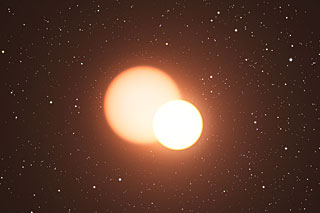 |
Projects
SB2 Cepheids
Classical Cepheids
Type II Cepheids
Papers
by category
by first author
by target
Visitors so far: 29906.

Relevant publication:
2015, ApJ, 806, 29 (← click to see the publication at ADS/arXiv)
We present here the first spectroscopic and photometric analysis of the double-lined eclipsing binary containing the classical, first-overtone Cepheid OGLE-LMC-CEP-2532 (MACHO 81.8997.87). The system has an orbital period of 800 days and the Cepheid is pulsating with a period of 2.035 days.
Using spectroscopic data from three high-class telescopes and photometry from three surveys spanning 7500 days we are able to derive the dynamical masses for both stars with an accuracy better than 3%. This makes the Cepheid in this system one of a few classical Cepheids with an accurate dynamical mass determination (M1=3.90 ± 0.10 M☉). The companion is probably slightly less massive (3.82 ± 0.10 M☉), but may have the same mass within errors (M2/M1= 0.981 ± 0.015). The system has an age of about 185 million years and the Cepheid is in a more advanced evolutionary stage.
For the first time precise parameters are derived for both stars in this system. Due to the lack of the secondary eclipse for many years not much was known about the Cepheid's companion. In our analysis we used extra information from the pulsations and the orbital solution from the radial velocity curve. The best model predicts a grazing secondary eclipse shallower than 1 mmag, hence undetectable in the data, about 370 days after the primary eclipse.
The dynamical mass obtained here is the most accurate known for a first-overtone Cepheid and will contribute to the solution of the Cepheid mass discrepancy problem.